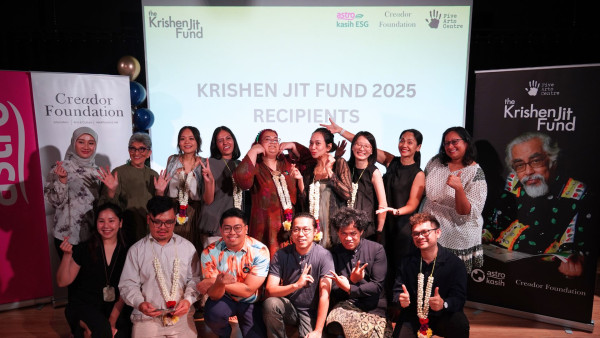
(This blog post originated from KAYPOH. For the full article, please visit KAYPOH's website.)
Review by Muhanniz Mesri
SUMMARY : “Yam Seng Lah!” was a theatre and dining experience by the award-winning Dabble Dabble Jer Collective, in collaboration with Michelin selected (2023 & 2024) casual dining restaurant Curios-City, Penang. The show ran from the 20th- 21st July and 27th-28th July, as part of Georgetown Festival 2024.
“Yam Seng!” is a celebratory toast that translates from Cantonese to mean “drink to victory,” traditionally extended to signify joy and prosperity. To perfect a Yam Seng, one must draw out the word “yam” before concluding with the word “seng” as breath wanes, toasting to life's various blessings. In “Yam Seng Lah!”, this toast extends to family, symbolizing a communal celebration of shared experiences.
Premiering at the George Town Festival 2024, “Yam Seng Lah!” presented an immersive culinary and theatrical experience. Through a blend of storytelling and gastronomy, six performers guide the audience on a multi-sensory journey that explores themes of family, identity, and personal history.
From my perspective as an audience and reviewer, “Yam Seng Lah!” as a show is to be properly understood through a semiotic lens. Semiotics is all about understanding how signs and symbols work and how they bring meaning. This performance uses food and storytelling as symbols to convey deeper stories about family, identity, and cultural heritage. So, rather than just seeing food as merely something to eat, it can be viewed as a way to connect with personal and cultural histories. In “Yam Seng Lah!”, storytelling and audience interactions also play a role in enhancing this symbolic exploration.
The performance unfolded through six acts, (each uniquely named after a locally-known dish and performed by a different actor): “Grandma’s Fried Chicken” by Yee Heng Yeh, “Sweet & Sour” by Ysabel Loh, “I Am Pekasam” by Darynn Wee, “Laksa Lessons” by Sofea Lee, “Life Is a Brief Khichdi” by Vilmett Thanakody, and “Love Is a Plate of Kesari” by Charity Yong.
 Cast members Yee Heng Yeh, Sofea Lee and Darynn Wee in one of the sequences of the show. Photo Credit : Dabble Dabble Jer Collective.
Cast members Yee Heng Yeh, Sofea Lee and Darynn Wee in one of the sequences of the show. Photo Credit : Dabble Dabble Jer Collective.
The dishes featured in “Grandma’s Fried Chicken” and “Sweet and Sour” serve as poignant reminders of familial bonds and the complexities of family relationships. These acts explored the experiences of characters who studied abroad and returned home to Malaysia, reflecting on the comfort they felt when their grandmother cooked these familiar dishes. “Grandma’s Fried Chicken” aimed to evoke childhood comfort and the nurturing love of a grandmother, connecting the audience with cherished memories of home. In contrast, “Sweet & Sour” used the difference in the flavors to symbolize the complexities of family relationships, reflecting both affection and conflict. However, the fine dining presentation style detracted from the intended symbolism of warmth and nostalgia. While the stories were personal and reflective, the upscale approach was at odds with the homely comfort described. This clash made it harder for me, at least to fully engage with the nostalgic themes and diminished the intimate connection I was expecting.
"I Am Pekasam'' on the other hand, explored cultural identity and marginalization through the semiotic lens of food. Pekasam, a traditional dish, is employed as a signifier of regional identity and cultural integration. The act centers on the performer's Bidayuh heritage and her experiences of being labeled as "lain-lain," using this dish to symbolize the complexities of belonging and the quest for a cohesive identity within a multicultural society. In this performance, the pekasam specifically refers to the Sarawakian version, a fermented dish from Borneo, which was brought in for the performance to enhance authenticity. Here the narrative delved deeper into the performer's unique cultural background, highlighting the challenges of navigating cultural identity and addressing the broader question of what it means to be Malaysian.
In "Laksa Lessons" the act centered on a girl whose parents' separation led her to live abroad before returning to Malaysia to stay with her father. The narrative utilized three types of laksa—Laksa Johor, Assam Laksa, and Laksa Kedah—as symbols of different facets of her cultural identity and personal preferences. Laksa Johor, which incorporated spaghetti as its noodles, inspired by Western cuisine signified elements of her heritage that she found challenging to connect with, reflecting a cultural divergence. Meanwhile, Assam Laksa represented an integration of Malay and Chinese culinary traditions, standing as a symbol of her blended cultural identity which mirrored the protagonist's negotiation between different aspects of her heritage. Laksa Kedah (her preferred variant) signified a deeper connection to her roots and a stronger sense of belonging which further symbolised the comfort and familiarity of her cultural roots, serving as a reminder of her intrinsic identity. Each type of laksa articulated her journey of cultural integration, identity formation, and the reconciliation of her past and present.
"Life Is a Brief Khichidi" employs khichdi, a traditional Indian dish that is made up of rice and lentils often served at communal gatherings and festivals, to evoke fond memories of grandmothers' cooking. This simple yet deeply meaningful dish symbolizes comfort, love, and familial bonds. The act's narrative highlights how the protagonist recalls every detail of their late grandmother's cooking and learns to recreate the dish to preserve her memory and legacy. The food served at the end of the act enhances the emotional impact, allowing the audience to physically and emotionally connect with the stories shared and deepen their nostalgic experience.
 Cast member Villmett Thanakody in “Life is a Brief Khichdi” preparing the dish as he tells his tale. Photo Credits : Dabble Dabble Jer Collective
Cast member Villmett Thanakody in “Life is a Brief Khichdi” preparing the dish as he tells his tale. Photo Credits : Dabble Dabble Jer Collective
In "Love Is a Plate of Kesari", kesari, a sweet Indian dessert, serves as a potent signifier of love and care within the family. The narrative explored how the protagonist remembers their late grandmother preparing this dish, with each step in the cooking process symbolizing cherished memories and acts of love. The protagonist's efforts to recreate the dish signify the continuation of familial traditions and the enduring nature of love through shared culinary practices. The act uses kesari to convey deep emotional connections and highlights the powerful role of food in expressing affection and preserving family bonds.
"I Am Pekasam", "Life Is a Brief Khichidi", and "Love Is a Plate of Kesari '' effectively utilized food as a symbolic element to engage the audience and deepen their connection to the narratives. In these acts, performers served the traditional versions of the dishes alongside their fine dining adaptations, allowing the audience to experience the original flavors before enjoying the refined versions. The hands-on food preparation process allowed for a more authentic interaction with the stories being told. The use of symbolic representation was evident as the dishes became symbols of cultural identity, familial bonds, and......(Continue reading)
-Large-web.jpg)

-web.jpg)


